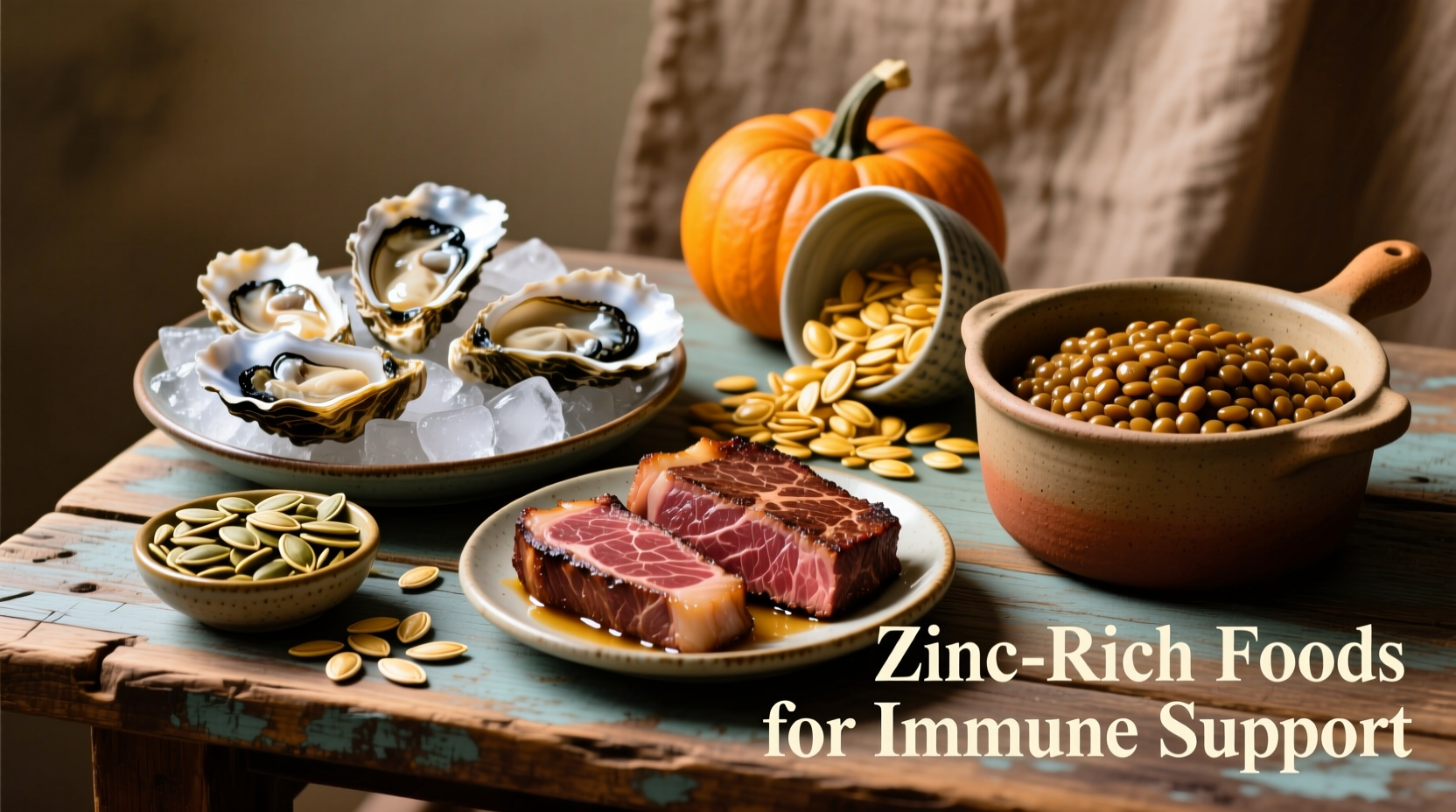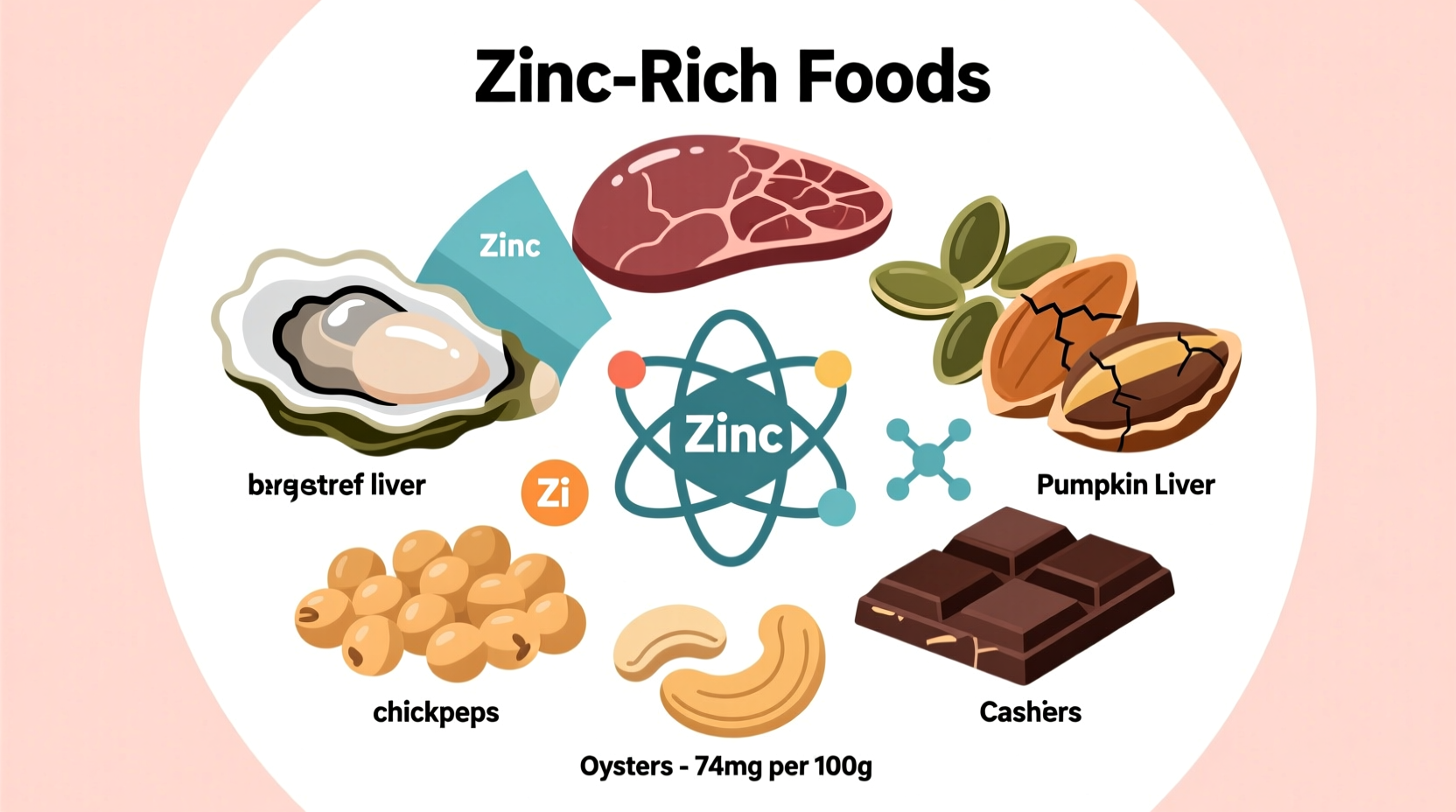The top natural food sources of zinc include oysters (which contain more zinc per serving than any other food), beef, crab, lobster, pork, chicken, fortified breakfast cereals, pumpkin seeds, cashews, chickpeas, and lentils. Just 3 ounces of cooked oysters provides over 400% of the daily recommended value, while a 3-ounce serving of beef delivers about 50%.
Understanding which foods naturally contain zinc is essential for maintaining optimal health. This essential mineral plays a critical role in immune function, DNA synthesis, wound healing, and cell division. Unlike some nutrients, your body doesn't store zinc, so you need to consume it regularly through your diet. Let's explore the best food sources to ensure you're getting enough of this vital nutrient.
Why Zinc Matters for Your Health
Zinc deficiency affects about 17% of the global population according to the World Health Organization. This mineral serves as a cofactor for over 300 enzymes in your body, supporting everything from your sense of taste and smell to proper growth and development during pregnancy and childhood. When you consistently include zinc-rich foods in your diet, you're supporting your body's ability to fight infections, heal wounds, and maintain healthy skin.
Top Animal-Based Zinc Sources
Animal proteins generally provide zinc in a more bioavailable form, meaning your body can absorb and use it more efficiently. Here are the most concentrated sources:
| Food | Portion Size | Zinc (mg) | % Daily Value |
|---|---|---|---|
| Oysters, cooked | 3 ounces | 74.1 | 674% |
| Beef shank, cooked | 3 ounces | 7.0 | 64% |
| Alaska king crab, cooked | 3 ounces | 6.5 | 59% |
| Lobster, cooked | 3 ounces | 3.4 | 31% |
| Pork shoulder, cooked | 3 ounces | 2.9 | 26% |
| Chicken thigh, cooked | 3 ounces | 1.6 | 15% |
According to the National Institutes of Health Office of Dietary Supplements, shellfish like oysters contain exceptionally high zinc levels because they filter zinc from seawater. Red meats like beef provide substantial zinc content per serving, making them reliable sources for omnivores. Even modest portions of poultry contribute meaningfully to your daily zinc requirements.
Plant-Based Zinc Powerhouses
For vegetarians, vegans, or those looking to diversify their zinc sources, several plant foods offer substantial amounts. However, it's important to understand that zinc from plant sources has lower bioavailability due to phytates that can inhibit absorption. Soaking, sprouting, or fermenting these foods can increase zinc absorption by 50-60% according to research published in the American Journal of Clinical Nutrition.
| Plant Food | Portion Size | Zinc (mg) | % Daily Value |
|---|---|---|---|
| Pumpkin seeds | 1 ounce | 2.2 | 20% |
| Cashews | 1 ounce | 1.6 | 15% |
| Chickpeas, cooked | 1 cup | 1.3 | 12% |
| Lentils, cooked | 1 cup | 1.3 | 12% |
| Mushrooms, cooked | 1 cup | 1.4 | 13% |
| Fortified breakfast cereals | 1 serving | Varies | Up to 50% |
Legumes and nuts provide the most substantial plant-based zinc sources. Pumpkin seeds stand out as particularly rich, offering nearly 20% of your daily needs in just one ounce. Many breakfast cereals are fortified with zinc, making them convenient options, especially for children who may have higher zinc requirements during growth spurts.
How Much Zinc Do You Really Need?
Daily zinc requirements vary by age, gender, and life stage. The Recommended Dietary Allowance (RDA) established by the National Academy of Medicine provides clear guidelines:
- Infants (0-6 months): 2 mg
- Children (7-12 months): 3 mg
- Children (1-3 years): 3 mg
- Children (4-8 years): 5 mg
- Children (9-13 years): 8 mg
- Teen boys (14-18 years): 11 mg
- Teen girls (14-18 years): 9 mg
- Adult men: 11 mg
- Adult women: 8 mg
- Pregnant women: 11 mg
- Breastfeeding women: 12 mg
Vegetarians may need up to 50% more zinc than the RDA because of lower absorption from plant foods. The National Institutes of Health notes that "zinc absorption from a vegetarian diet is lower than from a diet that includes meat, but adaptation over time appears to enhance zinc absorption in vegetarians."

Maximizing Zinc Absorption From Your Diet
Simply eating zinc-rich foods isn't enough—you need to optimize absorption. Here's how:
- Pair with protein: Animal proteins enhance zinc absorption, which is why meat eaters typically have better zinc status.
- Soak legumes and grains: This reduces phytate content, increasing zinc bioavailability by 20-30%.
- Avoid coffee/tea with meals: Tannins can inhibit zinc absorption by up to 50%.
- Space out calcium supplements: High calcium intake at the same time as zinc can reduce absorption.
- Include fermented foods: Sauerkraut, kimchi, and sourdough bread have reduced phytate levels.
For those following plant-based diets, combining zinc-rich foods with organic acids like citric acid (found in citrus fruits) can improve absorption by creating more soluble zinc complexes, according to research from the Journal of Nutrition.
Special Considerations for Different Diets
Whether you follow a specific dietary pattern, you can meet your zinc needs with careful planning:
- Mediterranean diet: Focus on seafood, poultry, legumes, and nuts which all contribute zinc.
- Vegetarian/vegan diets: Prioritize pumpkin seeds, cashews, chickpeas, lentils, and fortified cereals while using preparation techniques that enhance bioavailability.
- Gluten-free diets: Include quinoa, buckwheat, and amaranth which provide more zinc than rice or corn.
- Low-FODMAP diets: Choose firm tofu, tempeh, and certain nuts/seeds while avoiding high-FODMAP legumes.
For individuals with digestive conditions like Crohn's disease or celiac disease, zinc absorption can be significantly compromised. The Mayo Clinic recommends working with a registered dietitian to develop a personalized zinc intake plan in these cases.
When Supplements Might Be Necessary
While food sources should be your primary zinc source, supplements may be appropriate in specific situations:
- Diagnosed zinc deficiency confirmed by blood tests
- Certain medical conditions affecting absorption
- Pregnant women with limited dietary variety
- Older adults with reduced appetite or absorption
Be cautious with supplementation—excessive zinc intake (more than 40 mg daily for adults) can cause copper deficiency and impair immune function. Always consult with a healthcare provider before starting zinc supplements, especially if you take medications like antibiotics or diuretics.
Practical Meal Planning Tips
Here's how to easily incorporate zinc-rich foods into your daily meals:
- Breakfast: Choose fortified cereal with pumpkin seeds and almonds
- Lunch: Prepare a chickpea salad with cashews and grilled chicken
- Dinner: Make a beef stir-fry with mushrooms and serve over quinoa
- Snacks: Keep roasted pumpkin seeds or cashews handy
- Weekly: Include at least one seafood meal featuring crab or oysters
For vegetarians, try this zinc-boosting meal: lentil soup with sautéed mushrooms, served with whole-grain bread and a side of cashew cheese. The combination of preparation methods and food pairings maximizes zinc availability from plant sources.











 浙公网安备
33010002000092号
浙公网安备
33010002000092号 浙B2-20120091-4
浙B2-20120091-4